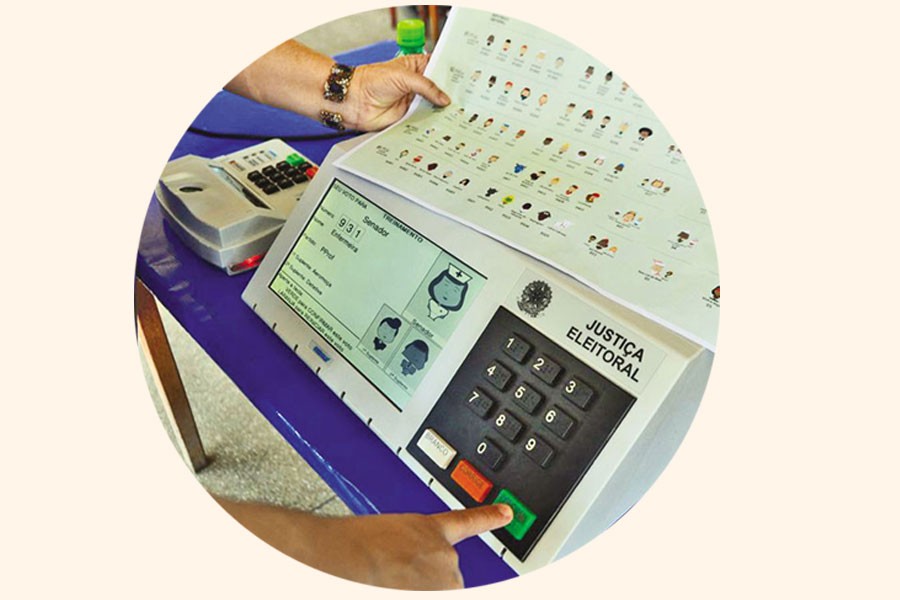
 Background: Electronic Voting and Electronic Voting Machines or EVMs have been the talk of the country in Bangladesh in recent times due to the controversial decision taken by the current Election Commission (EC) to use these machines in 50 per cent of the constituencies during next parliamentary election. The EC has taken such a decision despite opposition from a majority of consulted political parties as well as vocal civil society members. As is well-known, Electronic Voting or E-Voting utilises electronic means in casting and counting of ballots during elections. Standalone electronic voting machines (EVMs) and computer-connected internet are used for the purpose. The degree of automation in such voting may range from transmission of tabulated results to fully functional online voting through connected devices. It may entail mere marking of a paper ballot to a comprehensive system of vote-inputting, vote-recording, data encryption, transmission to server, consolidation, and tabulation of election results.
Background: Electronic Voting and Electronic Voting Machines or EVMs have been the talk of the country in Bangladesh in recent times due to the controversial decision taken by the current Election Commission (EC) to use these machines in 50 per cent of the constituencies during next parliamentary election. The EC has taken such a decision despite opposition from a majority of consulted political parties as well as vocal civil society members. As is well-known, Electronic Voting or E-Voting utilises electronic means in casting and counting of ballots during elections. Standalone electronic voting machines (EVMs) and computer-connected internet are used for the purpose. The degree of automation in such voting may range from transmission of tabulated results to fully functional online voting through connected devices. It may entail mere marking of a paper ballot to a comprehensive system of vote-inputting, vote-recording, data encryption, transmission to server, consolidation, and tabulation of election results.
TYPOLOGIES AND CATEGORIES: A credible E-Voting system should comply with the standards set by regulatory bodies that ensure complete security, accuracy, integrity, speed, privacy, auditability, accessibility, cost-effectiveness, scalability, and ecological sustainability. The technologies applied may involve: punched cards, optical scan-based voting system, and specialised voting kiosks that deploy Direct-Recording Electronic (DRE) voting system. The transmission of ballots or votes can take place via telephones or through computer network-based internet. Electronic voting may be supervised by the representatives of electoral authorities, as is the case with EVMs in polling centres. Or as in case of remote voting via the internet, also called I-Voting, the votes are submitted electronically to the election authorities from any venue or place.
The electronic voting systems can therefore be categorised into: paper-based system; DRE system; public network DRE system; and online voting.
GENESIS AND EVOLUTION: Electronic voting system has been in vogue since the 1960s. The USA was the pioneer in the field when seven of its counties switched to a punched card-based method during the 1964 presidential election. A later innovation or 'optical scan voting system' allowed computers to count voting marks on ballots. These DRE voting machines or EVMs are now used in all elections held in India and Brazil, and to a large extent in the USA and Venezuela. However, they have been decommissioned in the Netherlands following public outcry on the question of reliability. On the other hand, internet voting system or I-Voting has gained popularity in countries like Switzerland and Estonia, and is also used in Canada's municipal elections as well as party-primaries in the USA.
CONTROVERSIES, CRITICISMS AND CONCERNS: The use of electronic voting system in elections worldwide has all along remained a contentious issue. Even advanced countries like the Netherlands and Germany have halted its use after questions were raised about its reliability. But the issue has become more complicated in some developing countries due to the involvement of numerous stakeholders including EVM manufacturers, political parties and ruling regimes who stand to gain through rigged or manipulated polls.
As pointed out by the eminent American cryptographer cum computer security analyst Bruce Schneier, "Computer security experts are unanimous on what to do (some voting experts disagree, but it is the computer security experts who need to be listened to; the problems here are with the computer, not with the fact that the computer is being used in a voting application)… DRE machines must have a voter-verifiable paper audit trail….. Software used on DRE machines must be open to public scrutiny in order to ensure accuracy of the voting system. Verifiable ballots are necessary, because computers can and do malfunction, and because voting machines can be compromised".
Use of default administration password may be one of the causes for insecurities found in EVMs. There have also been reports of unpredictable and inconsistent errors in these machines. Additional issues raised include openness of the system to public examination, creation of an authenticable paper record of votes cast, and a chain of custody for records. There is even a risk that EVM results can be changed by the manufacturer or administrator, and there is no fool-proof guarantee regarding the accuracy of gathered and reported results.
There have been allegations even in the USA that DRE voting can facilitate electoral fraud. Although countries like India continue to deploy EVMs, several developed countries including the Netherlands, Germany, France, Ireland and the UK have either cancelled E-Voting system or decided against its large-scale roll-out. Only 13 countries of the world out of 178 currently use EVMs in elections.
It should be pointed out that people deprived of internet access or the skills needed to use machines find themselves at a disadvantage while going for e-voting. This is especially true for developing countries like Bangladesh, where literacy and e-literacy rates are still quite low. Trust is also a huge factor here, as voters fear that their votes can be changed by viruses or malwares in the machines, or while transmissions are made to affiliated servers.
BANGLADESH PERSPECTIVE: Incumbent Chief Election Commissioner (CEC) Kazi Habibul Awal had claimed following dialogues with political parties in July this year that most parties did not have faith on EVMs. But astonishingly, the Election Commission (EC) subsequently resorted to a distorted narrative regarding the opinions of parties on EVMs and declared its intention to use these machines in half the constituencies during the upcoming parliamentary election. Even the CEC had acknowledged that the commission was suffering from a crisis of confidence. Therefore, this zealousness on the part of EC to opt for EVMs on such a large scale by spending about Taka 90 billion has given rise to more suspicions in the public mind.
The valid questions that have been raised by Bangladeshi civil society members against deployment of EVMs during elections include the following.
Firstly, there is no existence of verifiable paper audit trail in the machines envisaged to be used by the EC, which has been identified as the biggest weakness in local EVMs. Consequently, it is not possible to opt for fresh counting or auditing of votes. That implies whatever result the EC announces has to be accepted. It may be recalled that the then technical adviser of EC and former Vice Chancellor of BUET late Professor Jamilur Reza Chowdhury had opposed the purchase of the locally manufactured EVMs in 2018 because of this weakness. Even in India, 'Voter Verified Paper Audit Trail' (VVPAT) was added to the EVMs of that country following an order issued by the Indian Supreme Court.
Secondly, the election officials of Bangladesh have been given the discretionary power to override EVMs. But if an official can open an EVM even when the finger-print of a voter does not match, then he can resort to voting in any manner he likes in the absence of others including voters. As none can see what the official has been doing, there is no scope for challenging any manipulation, and this can directly contribute to changing the election outcomes. According to a BBC report, the election officials were given the right to override in cases involving 25 per cent of voters, but even a few per cents may prove decisive in highly contested polls.
Thirdly, the electronic voting system involving EVMs currently used in Bangladesh lacks the capacity to collate or compile results in an automated manner, which has been identified as a massive weakness. As a consequence, it takes hours before the final results can be obtained, as the results are prepared manually after the numbers from polling-booths are passed on. This manual system can therefore be exploited for changing election outcomes.
Fourthly, EVMs are run through computer program-based commands. Therefore, they have to be configured through programming for each constituency, because the candidates vary.
Experts opine that manipulation through computer programming is very much possible.
Fifthly, the EVMs remain under the control of EC, and consequently its technical team has the leverage to amend or change results. It may be recalled that the results were announced at least twice during the last mayoral election of Chittagong City Corporation, and many observers believed that the finally announced result was arrived at through digital manipulation. Serious allegations were also raised during the city corporation elections held in Narayanganj and Cumilla in the recent past. The results can be changed even by preparing duplicate or second sets of audit cards used in compiling results.
Sixthly, information on all voters in a centre is not found in all individual polling booths. As a result, it is not possible to cast vote through another EVM when a booth's machine goes out of order, or it is unable to identify the biometrics of voters. EVMs have also been accused of being complicit in usurping the voting rights of people due to complexities in voter identification through biometrics, hanging of machines during the voting process, and lack of awareness about these machines among the public. Even during the highly controversial and allegedly rigged parliamentary election of 2018, average voter turn-out in constituencies that used EVM was less by 30 per cent compared to other constituencies.
EVMs are considered to be 'black-boxes', and the common people often remain suspicious about them. This is because the voting process is not visible like paper balloting, where ballots are thrown into transparent boxes after the voters put seals on them; the counting then takes place before the eyes of polling agents. In fact, one has to be a forensic expert in order to ensure transparent voting through EVMs, which does not conform to the reality on the ground in Bangladesh.
The climatic condition of Bangladesh also does not favour these machines, as the humidity can prove to be harmful if the EVMs remain out of use for a long time. According to information provided by the Election Commission (EC) of Bangladesh, out of 93,410 EVMs previously bought by the EC, 30 per cent have gone out of order; and the rest of the machines are also not risk-free.
Observers also point to the fact that it has not yet been possible to prepare flawless NID and Biometric Database in Bangladesh for all eligible voters, as millions of complaints about errors and omissions have been lodged against it. It is now virtually impossible to make this database fully updated and error-free within 2023. In this backdrop, holding of polls in 150 constituencies through EVMs is totally unrealistic and illogical, and not at all feasible, if the authorities have a hidden agenda detrimental to free and fair democratic elections in this country.
Dr Helal Uddin Ahmed is a retired Additional Secretary, former Editor of Bangladesh Quarterly, and currently Editor of FBCCI Business Review.
hahmed1960@gmail.com
© 2025 - All Rights with The Financial Express
